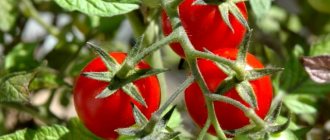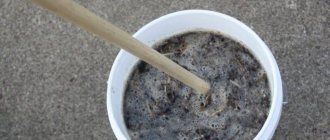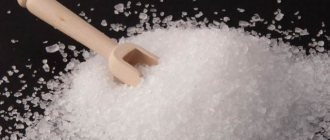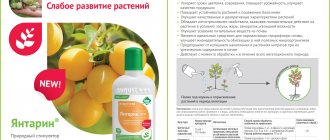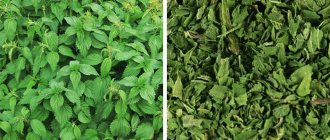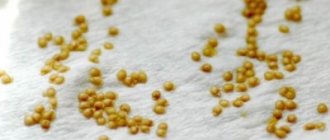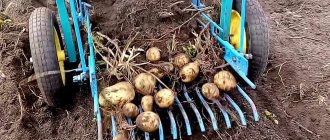Why is calcium needed in soil?
- to accelerate the decomposition of organic matter in the soil and the formation of humus,
- to reduce the toxicity of manganese and aluminum in the soil by neutralizing their excess amounts,
- to improve the mechanical composition of the soil, improve its air and water permeability properties.
dolomite is one of the most famous calcium-containing fertilizers
Fertilizer application
Methods of feeding calcined nitrate, application time and dosage directly depend on the type of soil and individual “preferences” of plants.
Soil types
Calcium nitrate is suitable for use on all types of soil.
Important : fertilizer, unlike urea, practically does not acidify the soil.
Recommended use:
- on a sod-podzolic substrate;
- on acidic soil.
When to deposit
According to experienced gardeners, calcined nitrate is best applied in early spring, before digging .
Autumn application does not produce results - calcium is not absorbed during the winter, and then all nitrogen is washed out from the site with melt water.
It is acceptable to apply in early spring directly during sowing or planting in a hole.
Foliar feeding for fruit plants is carried out from the moment the first ovary is formed. The application interval is 2-3 weeks.
The last application is the end of July - the first ten days of August, depending on the region. In the future, it is more advisable to use fertilizers without a nitrogen component.
Instructions for use
The optimal way to apply calcium nitrate is by foliar feeding of already growing plants.
It is economical to use fertilizer in liquid solutions through drip irrigation or irrigation. The method is safer - when sprayed, a minimal amount of nitrates penetrates into the soil and fruit.
Foliar feeding with calcium nitrate - recommendations :
- The first spraying of cucumbers is carried out during the period when the seedlings have 3 true leaves;
- repeated feeding is carried out before flowering;
- for blossom end rot of tomatoes, it is more advisable to apply fertilizer not into the hole, but through spraying;
- 2-3 treatments per season are enough to prevent fungal and bacterial infections;
- Fertilize cabbage directly when planting seedlings in open ground;
- Ornamental plants are fed during the period when flower stalks are released; the treatment prevents the stems from stretching.
What happens when there is a lack of calcium? 3 sad results:
1. The roots of the plant are damaged: with a lack of calcium, the root system of the plant suffers first, because the growth of lateral roots and root hairs stops, which leads to a decrease in water consumption and, consequently, to a deterioration in plant nutrition. Damage to the root system will manifest itself in sliming of root hairs.
2. Leaves, stems and buds of plants are damaged: lack of calcium leads to rotting of individual parts of the stem and leaves of the plant. As a rule, the leaves first turn white along the edges, then turn black, curl, or simply lose their shape and bend. In bulbous crops, with a lack of calcium, a weaker, drooping peduncle can form, which leads to a decrease in the decorativeness of the plant. Also, with a lack of calcium, flowers, ovaries and buds may fall off.
Cabbage is highly sensitive to calcium.
3. Fruits are damaged: with a lack of calcium, necrosis (necrotic spots) may appear on fruits. This can be observed on apples, pears, etc.
However, it is still worth saying that calcium deficiency is more rare than common. These problems, like most others, are typical mainly for acidic soils and there is only one treatment - liming the soil, optimally - adding dolomite. Read more: Dolomite flour in practical advice: when, where and in what quantities to pour dolomite>>>
Adequate plant nutrition is not only one of the main factors for a high yield of high-quality products, but ultimately it is adequate nutrition and health for people. We presented a detailed, step-by-step recipe for effective and complete nutrition of tomatoes and cucumbers in protected soil in 2022 in No. 5 of the Gavrish magazine. This is a basic technology for root nutrition, but intensive technology for cultivating vegetable crops is impossible without foliar feeding.
Foliar feeding in intensive technology is one of the most important elements of the strategy for controlling growth and production processes in a plant. The most powerful tool for operational influence on the processes that determine the harvest and its quality.
Practice shows that it is the combination of foliar feeding and fertigation (or root nutrition) that allows you to most fully reveal the potential of productivity while simultaneously increasing quality indicators. The synergistic effect of these techniques is proven and undeniable. In this case, special attention should be paid to those essential nutrients that are not recycled in the plant body, but are constantly needed by young and growing organs and tissues. Here a special role belongs to Calcium.
For many vegetable crops, the removal of calcium per unit yield is comparable to the removal of nitrogen, and crops such as pumpkin, cabbage, Chinese cabbage and kohlrabi consume even more calcium than nitrogen. Calcium is one of the necessary structural and potential-forming elements with certain specific functions. It is responsible for the structural and physiological stability of cells and tissues, enhances metabolism in plants, affects the activity of enzymes and the conversion of nitrogenous substances, plays an important role in photosynthesis and the movement of carbohydrates, affects the physicochemical state of protoplasm - its viscosity, permeability and others properties on which the normal course of biochemical processes depends.
Calcium has a beneficial effect on root growth and plays a major role in reducing the toxic effects of excess other elements, including ammonium, manganese and aluminum ions. By delaying the excess entry of some elements into the cell, it at the same time stimulates the absorption of others that are lacking.
With a normal level of calcium nutrition, nitrogen absorption increases 2-3 times. In plants well supplied with calcium, auxin synthesis is enhanced, and plant resistance to the stressful effects of pesticides and other negative factors increases.
The main calcium-containing fertilizer in vegetable growing, both open and protected soil, is calcium nitrate (synonyms: calcium nitrate, or calcium nitrate). The optimal balance of calcium in the nutrient solution ensures normal growth and development of the plant, but cannot prevent the occurrence of physiological calcium deficiency in juicy fruits, because this element is not reutilized in the plant organism and does not move well with the ascending current into young organs and tissues. In juicy fruits, 90% of calcium is localized in cell walls, membranes and intercellular plates - lamellae, where calcium compounds with pectin substances “glue” the cell walls together. During the period of fruit growth, active cell division occurs, which requires additional calcium for the formation of new cell walls. At the same time, in parallel, the amount of moisture consumed increases, which naturally reduces the concentration of calcium in localized areas, causing physiological deficiency and weakening adhesive functions. As a result, the growing point of the cucumber may die, the leaves lose turgor and become dome-shaped, and the fruits do not have sufficient hardness. In tomatoes, peppers and eggplants, the ovary may fall off, and on fruits, due to intercellular gaps in places of intense cell division, where infection subsequently penetrates, blossom end rot develops.
Death of the growing point and dome-shaped leaves of cucumber with acute calcium deficiency.
Blossom rot on tomato, eggplant and sweet pepper fruits due to calcium deficiency.
Physiological calcium deficiency leads to large losses of the economic part of vegetable crops. This disease is not pathogenic in nature, so fungicides cannot solve this problem. Preventing the development of deficiency is possible only with the help of periodic foliar feeding throughout the entire fruiting period, which allows calcium to be effectively delivered to the places of greatest need. For foliar feeding, as a rule, specialized forms of calcium that do not contain nitrogen are used. There are a lot of water-soluble calcium-containing substances, but not all of them are suitable for such intake. These chemicals can be roughly divided into two main groups:
1. Inorganic salts - Calcium chloride (CaCl2) - is not a fertilizer, high chlorine content can cause phytotoxicity, leaf necrosis, rust, etc. (the chemical is not registered as a fertilizer, but some farmers use it because it is cheap); — Calcium nitrate (Ca(NO3)2) – high nitrogen content is undesirable during the period of fruit filling, it worsens the quality, and stimulates vegetative growth. Physiologically alkaline fertilizer - high concentrations cannot be used.
2. Organic compounds - Calcium chelate Ca (EDTA) - low stability of the compound in light and in water with pH > 6.5, there is a risk of phytotoxicity. Excess leads to subcutaneous “golden spot” of tomato formed by calcium oxalates; — Calcium complexes with amino acids or lignosulfonic acid Ca (LSA) – high stability of the compounds and a high degree of calcium absorption. There is no risk of phytotoxicity.
The AgroMaster Group of Companies has five types of calcium nitrate from domestic and foreign manufacturers in its arsenal, and in 2012 the company began developing a special calcium-based agrochemical for foliar feeding, under the brand name AgroBor Sa. The fertilizer contains 20% CaO combined with lignosulfonic acid and 0.9% boron. Boron stimulates the movement of calcium through tissues and improves its absorption.
The first scientific experiments on open ground tomatoes showed the high efficiency of the agrochemical. Thus, three times foliar feeding with an interval of 15 days from the formation of the ovary of General F1 hybrid tomato plants, with AgroBor Ca in dosages of 0.5 - 1.0 l/ha, contributed to the intensification of growth processes and photosynthesis, which had a positive effect on the formation of fruits and their quality. As a result, there was an increase in the diameter and weight of the fruit by 0.4-1.1 cm and 11-34 g, respectively. The content of sugars increased by 0.2-0.5%, vitamin C - by 3.3-8.1 mg/100 g of raw material. The increase in fruit yield was 24.5-35.8 c/ha or 8.7-12.7%, with the yield in the control being 280.9 c/ha (KubSAU, 2012). It should be noted that the extreme weather conditions of 2012 were generally unfavorable for all agricultural crops, incl. and for tomatoes.
In 2014, AgroBor Sa received State registration, and since then it has been successfully used in the Russian Federation and CIS countries. In 2022, the agrochemical was tested by the Republican Unitary Enterprise “Institute of Soil Science and Agrochemistry”, Minsk, to obtain registration in the Republic of Belarus.
The tests were carried out at Ozeritsky-Agro OJSC, Smolevichi district, Minsk region, on the Makhitos F1 tomato grown in a greenhouse on a mineral wool substrate. The seedlings were planted on mineral wool on July 12, 2017, with a planting rate of 2.5 plants per 1 m2. The area of the registration plot was 56.8 m2, the location of the plot was randomized, the repetition was fourfold, there were 2 options. The experimental scheme was as follows: 1. Standard - Nutrition technology used at Ozeritsky-Agro OJSC, based on a low-volume method on a mineral wool substrate - system drip irrigation with a compensated dropper (without treatment with the tested fertilizer) – background. 2. Test fertilizer – Background + 1st fertilizing in the flowering phase of 1-3 brushes with AgroBor Ca (1.3 l/ha) + 2nd fertilizing in the flowering phase of 4-6 brushes with AgroBor Ca (1.3 l/ha) ha) + 3rd fertilizing in the flowering phase of 6-12 brushes with AgroBoron Ca (1.3 l/ha).
The agrochemical AgroBor Ca was used in the form of foliar fertilizing - the 1st treatment was carried out on 08/03/2017, the 2nd treatment was carried out on 08/17/2017, the 3rd treatment was carried out on 09/01/2017. Yield recording with the selection of tomato fruits to determine indicators quality was carried out three times - 09/26/2017, 10/09/2017 and 10/19/2017. The selection of fruits was carried out by greenhouse employees. No side effects from the use of the studied AgroBor Ca on vegetative tomato plants cultivated in protected soil conditions were identified.
The quality of tomato fruits was determined by the following indicators: mass concentration of dry substances in solution in terms of sucrose and nitrate content, for each of three selections. AgroBor Ca as a foliar fertilizer led to an improvement in the quality of tomato fruits in terms of this indicator. Thus, in the first selection there was a tendency to increase, and in the second and third selections there was a significant increase in sugar content by 0.4°Bx compared to the standard. The nitrate content in all experimental variants for all selections complied with the sanitary standards adopted in the Republic of Belarus and was in the range of 14.1-127.0 mg/kg wet weight, with the MPC for nitrates equal to 150 mg/kg wet weight. It should be noted that there were higher values for this indicator in the reference variant in the first two selections (Table 1).
Table 1 – Indicators of the quality of tomato fruits Makhitos F1 at Ozeritsky-Agro OJSC, Smolevichi district, Minsk region, 2017.
| Options | Mass concentration of sugars, degree Brix | Nitrate content, mg/kg wet weight | ||||
| 1st selection | 2nd selection | 3rd selection | 1st selection | 2nd selection | 3rd selection | |
| 1. Standard – Tomato nutrition technology used at Ozeritsky-Agro OJSC (without treatment with the tested fertilizer) – Background | 4,8 | 4,2 | 4,4 | 127,0 | 66,6 | 16,1 |
| 2. Background + three fertilizing with AgroBor Ca at 1.3 l/ha | 5,1 | 4,6 | 4,8 | 96,0 | 20,1 | 19,2 |
| NSR05 | 0,28 | 0,26 | 0,25 | – | – | – |
| MPC for nitrate content 150 mg/kg wet weight | ||||||
The effect of the agrochemical AgroBoron Ca on the yield of tomato fruits is shown in Table 2.
Table 2 – Productivity of tomato fruits Makhitos F1 at OJSC “Ozeritsky-Agro”, Smolevichi district, Minsk region, 2017
| Options | Productivity, kg/m2 (amount for three selections as of October 19, 2017) | |
| when cleaning | increase to the standard | |
| 1. Standard – Technology used at OJSC “Ozeritsky-Agro” (without treatment with the tested fertilizer) – Background | 6,13 | – |
| 2. Background + three fertilizing with AgroBor Ca at 1.3 l/ha | 6,72 | 0,59 |
| NSR05 | 0,308 | |
At OJSC “Ozeritsky-Agro”, the total yield obtained for three selections from September 26, 2017 to October 19, 2017 was 6.13 kg per 1 m2 of greenhouse. Three-fold foliar feeding of vegetative tomato plants with the tested liquid fertilizer AgroBorCa at a dose of 1.3 l/ha against the background of the use of tomato cultivation technology adopted by Ozeritsky-Agro OJSC provided a significant increase in tomato fruit yield by 0.59 kg/m2 (+ 9.6%) in relation to the standard, and amounted to 6.72 kg/m2, while there was an improvement in fruit quality indicators in terms of sugar content.
Periodic foliar feeding with a special calcium-containing agrochemical AgroBor Ca throughout the entire period of growth and fruit filling, against the background of complete root nutrition, including and calcium nitrate, avoid losses of the economic part of the crop, increase the yield of marketable products and their competitiveness in the vegetable market, as they prevent the development of diseases associated with calcium deficiency, increase its content in cell walls, improve the structure of fruits and, consequently, their shelf life, keeping quality, transportability, presentation and quality.
Leading specialist of AgroMaster Group of Companies
to agricultural science, Khoroshkin A.B.
Krasnodar region, Timashevsk
Limestone flour, or dolomite flour, dolomite
Dolomite or limestone flour is a natural fertilizer for acidic soils - a yellow, gray-yellow or rarely white powder consisting of approximately 30% calcium oxides and 20% magnesium oxides with an admixture of iron, manganese, zinc and phosphorus. Soil deoxidation using dolomite flour: where can you not do without dolomite?>>>
Limestone flour is capable of providing the soil with cadium in large quantities, but the effect of its use is rather “slow”. And it cannot be used for neutral or carbonate soils.
Potassium sulfate (potassium sulfate)
In addition to nitrogen and phosphorus in the spring, plants can also benefit from potassium, which promotes resistance to diseases and adverse weather conditions. Potassium helps plants absorb nitrogen, increases the rate of protein formation, increases tissue strength, and reduces nitrate content.
Among the “spring” potassium fertilizers, potassium sulfate is most often used, where the content of the main substance is about 50% and there is no chlorine. When digging up the soil for vegetables and fruits in the spring, add 15-25 g of this highly effective fertilizer per 1 sq.m and then water the soil abundantly (granules can also be added dissolved in water).
Potassium sulfate cannot be used simultaneously with chalk and urea.
The fertilizer is suitable for most plants, but cruciferous plants and legumes “love it” the most. Crops need potassium fertilizers most when growing in calcareous areas, since the salt content in such soil is minimal. Potassium sulfate is also recommended for use on acidic soils - it helps regulate their acid-base balance.
- Potash fertilizers - what are they, their names, meaning and application
Let's figure out why fertilizing with potassium fertilizers is needed.
If plants need potassium fertilizing during the growing season, you can prepare a solution of potassium sulfate to spray them. To do this, 35-40 g of granules are dissolved in 10 liters of water, mixed until completely dissolved and the green mass is sprayed.
Calcium nitrate
Synonyms for calcium nitrate: calcium nitrate, Norwegian nitrate, calcium nitrate, calcined nitrate, calcium nitrate
Water-soluble fertilizer with a high content of nitrogen (13-15%) and available calcium (19-27%). Chemical formula - Ca(NO3)2, externally - white powder without taste, color and odor, highly soluble in water.
Calcium nitrate is an alkaline fertilizer suitable for ALL soils, especially acidic ones.
When is the best time to apply calcium nitrate?
Calcium nitrate can be applied throughout the growing season with watering and in dry form. It is used mainly as a nitrogen fertilizer and is considered the most effective for spring feeding of winter crops.
Calcium nitrate is not applied in the fall, during digging or plowing. Because During autumn planting, the fertilizer will decompose with the release of nitrogen. And without nitrogen, calcium will not be absorbed by plants, which means the benefits of the fertilizer will be minimized.
Calcium nitrate consumption rate
The consumption rate of calcium nitrate is 20 g/m2 when feeding both vegetable and ornamental crops.
Features of calcinite
Calcinit is a 100% water-soluble fertilizer (water-soluble calcium nitrate) that is used in drip irrigation and hydroponics.
The use of calcium nitrate promotes the rapid growth of good root mass by plants. Such calcium instantly becomes available to plants, does not evaporate, is not fixed by the soil, and improves the absorption of potassium, calcium and magnesium cations by the plant. In addition, it is a good source of nitrogen.
Calcite consumption rates for root feeding:
- Strawberries, or garden strawberries – 25 g / 10 l. Fertilizing is carried out strictly before flowering begins.
- Vegetables (calcium tolerant) – 20 g / 10 l. Fertilizing is carried out before flowering.
- Fruit trees (apple trees, pears), shrubs – 25-30 g / 10 l. Fertilizing is carried out before the buds open.
- Foliar feeding with calcionite - 1-2 g / 1 l of water (1-2 kg per 100 l).
Calcyonite cannot be mixed with other fertilizers; it is applied separately.
Is it possible to mix calcium nitrate with other mineral fertilizers and chemicals?
should not be mixed with fertilizers containing phosphates and sulfates, due to the precipitation of nutrients into an insoluble precipitate. For this reason, calcium is usually not included in complex fertilizers.
Also, calcium nitrate cannot be applied simultaneously with pesticides, herbicides and growth stimulants.
Folk remedies with calcium for feeding tomatoes
Folk remedies with calcium for feeding tomatoes are wood ash and eggshells. Their application has the following features:
- You can prepare wood ash yourself. To do this, they burn boards, plant residues, and tree branches. The resulting ashes are generously distributed over the area prepared for planting tomatoes, or poured into the holes. A solution is also prepared based on wood ash (3 tbsp per bucket of water). They feed tomatoes at the root. You can also spray their leaves with filtered liquid.
- Eggshells as a calcium-rich fertilizer are often used to feed tomatoes.
The shells of three eggs are ground in a mortar, meat grinder or blender, pour in 1 liter of water, and leave until the characteristic smell of hydrogen sulfide appears. The resulting solution is used to irrigate tomato bushes. Important! Recent studies show that calcium is well absorbed by plants in liquid form, and in egg shells the element is contained in the form of an insoluble salt. Therefore, many gardeners have doubts about the effectiveness and speed of action of this fertilizer.
Calcium chelate
A bioavailable form of calcium, a combination of mineral and acid. Chelated compounds are highly effective; they are the only fertilizer that contains calcium that is completely available to plants without the “load” of other nutrients, such as calcium nitrate—nitrogen. Therefore, in cases where the crop is already “fatten” and NITROGEN is not needed in any case, then the best option is calcium chelate. Calcium deficiency can be quickly reduced by watering or spraying with the drug. This solution is used, for example, to treat blossom end rot in tomatoes overfed with nitrogen.
